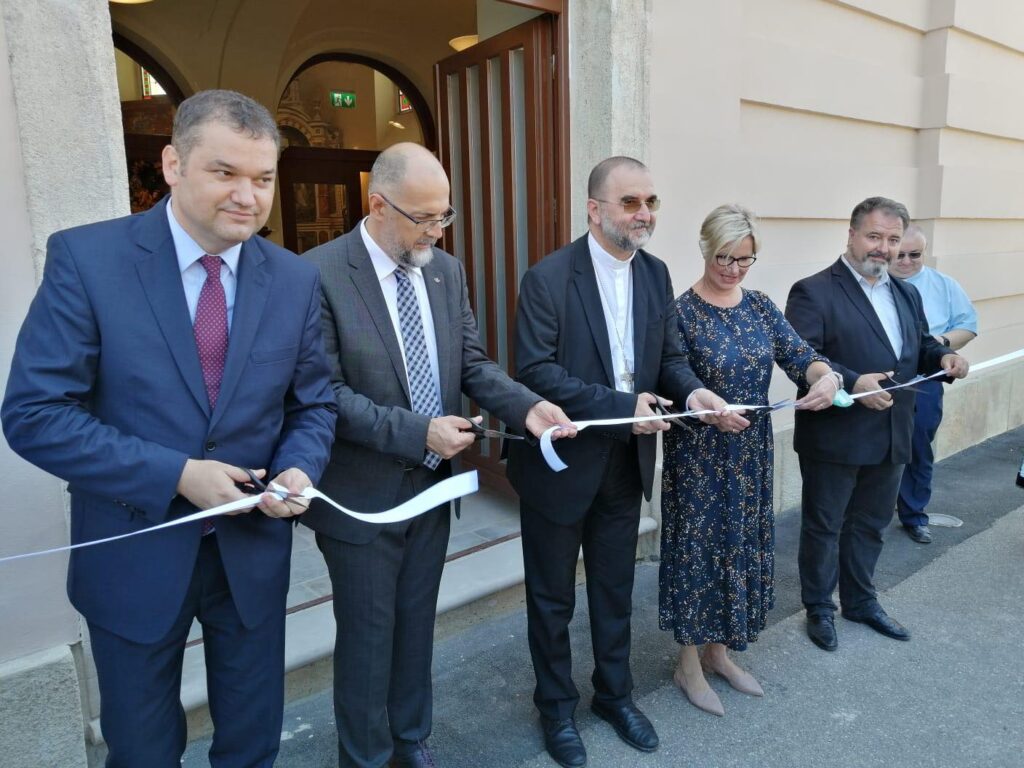The renovated Franciscan church and monastery in Szamosújvár (Gherla, Armenopolis) opened to the public on Friday. Following the festive technical handover of the restored buildings, Archbishop of Gyulafehérvár (Alba-Iula) Gergely Kovács, Deputy Prime Minister Hunor Kelemen and Minister for Development Attila Cseke symbolically opened the renewed Baroque church and monastery.The 18th century building complex is commonly known under the name of the Franciscan Church and Monastery of Szamosújvár, as for more than 250 years, the edifices belonged to the Franciscan order. The Franciscans gave the church and the monastery building to the Roman-Catholic Archdiocese of Gyulafehérvár in 2001 to use as a place of pastoral service for the Roman Catholic community.
Hunor Kelemen, who is also president of the Democratic Alliance of Hungarians in Romania (known by its Hungarian acronym of RMDSZ) congratulated the community and the parish priest both at the opening ceremony and in a Facebook post. “The community of less than 400 Roman Catholics, nearly 100 Armenian Catholics, and the parish priest Attila Küsmődi have defied the odds and made their dream a reality. They managed to apply for funds and assemble a restoration team, which has admirably renovated one of the city’s most valuable Baroque monuments,” Kelemen said. As the politician emphasized, the enthusiastic attitude of the priest and community yielded great results: Beyond the renewal of a house of God, a 21st century religious and research center, an Armenian and Roman Catholic archive, and a library are also being established in the historic building complex.

The extensive renovation of the 18th century Franciscan church and its monastery, which has been functioning as a parish church since 2001 was mainly financed by the European Regional Development Fund, but it also received additional Romanian state funding under the renovation program for historical monuments of regional importance. The value of the investment approached RON 21 million.
Construction engineer Béla Sárosi, sales manager for the main contractor, the KÉSZ Romania construction company, told the press before the handover ceremony that several interventions had to be carried out on the buildings: Foundations had to be consolidated, a great number of mural paintings were restored, and a proper heating and lighting system had to be installed in the church and monastery.
During the extensive interior and exterior renovation, the tower received a new cladding, the clock’s mechanism and the framework of the bells have been replaced, and an automatic bell system was installed. According to the engineer, they loaded a total of 25 trucks with bird droppings and dead pigeons to be transported away; they also had to replace about 20 percent of the timber in the roof structure of the church.
In the nave, the murals and the paintings on the ceiling have been restored, the wooden furniture cleaned and polished, and the stone pavement replaced. Under the benches, an underfloor heating system was installed. The main altar has also been completely restored, and its missing elements replaced.
The so-called Loretto chapel – which was built in 1760, a couple of years after the church was finished (in 1757) – has been attached to the church with traction irons, as its foundation had started to sink, and its roof structure was replaced. The crypt under the church was cleaned, paved, and given a modern lighting system. Also, a lift was installed, which runs between the crypt, the ground floor and the first-floor oratorio and can be used by disabled people.
The rooms in the former monastery were replastered, and the cloister’s windows and doors were replaced with thermally insulated windows adapted to the architectural style of the building. The rooms were provided with lighting technology typical of exhibition halls, and their pavement has been renewed. While some areas have a solid oak floor, the corridor has pine flooring. The electrical system of both the church and the monastery was modernized as well, and monitoring systems and security cameras were installed.
According to the parish priest, who initiated the renovation, prepared the applications and supervised their implementation, there are currently less than 400 Roman Catholics and nearly 100 Armenian Catholics living in Szamosújvár. The renovated Baroque building complex will house several community areas, an archive, a library and a museum.
Title image: Detail from the renewed interior of the Franciscan church in Szamosújvár. A 21st century lighting technology was installed in both the church and the monastery building.
Source: Kelemen Hunor/Facebook/Photo: Tamás Gönczy